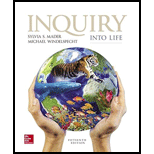
To describe:
The structural and functional features of macromolecules present in our body.
Introduction:
Carbohydrates, proteins, lipids, and
Explanation of Solution
Structure
Carbohydrates are naturally occurring compounds which are composed of carbon, hydrogen, and oxygen. Carbohydrates are formed by the combination of saccharide units and are further classified into monosaccharides, disaccharides, oligosaccharides, and polysaccharides on the basis of a number of saccharides units in the chain. Monosaccharides are the simplest sugars, for example, Glucose, Fructose, etc.
Proteins are formed by the combination of amino acids. There are 20 different types of standard amino acids which combine in a different sequence and give rise to different proteins.
Nucleic acids are also formed from smaller units known as
Lipids- There is no common structure of lipids. Generally, triglycerides and phospholipids are the commonly occurring lipids. Triglyceride has a glycerol backbone which is connected with three fatty acids. The phospholipids have glycerol, fatty acids, low molecular weight alcohol, and phosphoric acids.
Functions: The macromolecules perform different functions, for instance, the basic function of carbohydrates is to act as an energy source for storage and structure of all the living things involved. In plants, the chief energy source is starch and the structure and support are given by cellulose. In animals, the chief energy source is glycogen and structure and support is provided by chitin.
On the other hand, the major function of proteins is providing assistance in cell repairing and making the new cells. They also serve as an important dietary and energy requirement. The functions of lipids are providing insulation and long-term energy storage along with controlling the fluidity of cell membranes.
The nucleic acids perform the functions of storing the genetic material and transferring the genetic information to ribosome for the synthesis of proteins. They also assist in holding the ribosomal units together.
Hence, it is concluded that there are four types of macromolecules which are lipids, proteins, carbohydrates, and nucleic acids. All macromolecules are different in their structure and also differ in their functions. Apart from this, it is also important to know that all macromolecules are significantly needed in the body.
Want to see more full solutions like this?
Chapter 14 Solutions
Inquiry into Life
 Human Anatomy & Physiology (11th Edition)BiologyISBN:9780134580999Author:Elaine N. Marieb, Katja N. HoehnPublisher:PEARSON
Human Anatomy & Physiology (11th Edition)BiologyISBN:9780134580999Author:Elaine N. Marieb, Katja N. HoehnPublisher:PEARSON Biology 2eBiologyISBN:9781947172517Author:Matthew Douglas, Jung Choi, Mary Ann ClarkPublisher:OpenStax
Biology 2eBiologyISBN:9781947172517Author:Matthew Douglas, Jung Choi, Mary Ann ClarkPublisher:OpenStax Anatomy & PhysiologyBiologyISBN:9781259398629Author:McKinley, Michael P., O'loughlin, Valerie Dean, Bidle, Theresa StouterPublisher:Mcgraw Hill Education,
Anatomy & PhysiologyBiologyISBN:9781259398629Author:McKinley, Michael P., O'loughlin, Valerie Dean, Bidle, Theresa StouterPublisher:Mcgraw Hill Education, Molecular Biology of the Cell (Sixth Edition)BiologyISBN:9780815344322Author:Bruce Alberts, Alexander D. Johnson, Julian Lewis, David Morgan, Martin Raff, Keith Roberts, Peter WalterPublisher:W. W. Norton & Company
Molecular Biology of the Cell (Sixth Edition)BiologyISBN:9780815344322Author:Bruce Alberts, Alexander D. Johnson, Julian Lewis, David Morgan, Martin Raff, Keith Roberts, Peter WalterPublisher:W. W. Norton & Company Laboratory Manual For Human Anatomy & PhysiologyBiologyISBN:9781260159363Author:Martin, Terry R., Prentice-craver, CynthiaPublisher:McGraw-Hill Publishing Co.
Laboratory Manual For Human Anatomy & PhysiologyBiologyISBN:9781260159363Author:Martin, Terry R., Prentice-craver, CynthiaPublisher:McGraw-Hill Publishing Co. Inquiry Into Life (16th Edition)BiologyISBN:9781260231700Author:Sylvia S. Mader, Michael WindelspechtPublisher:McGraw Hill Education
Inquiry Into Life (16th Edition)BiologyISBN:9781260231700Author:Sylvia S. Mader, Michael WindelspechtPublisher:McGraw Hill Education





